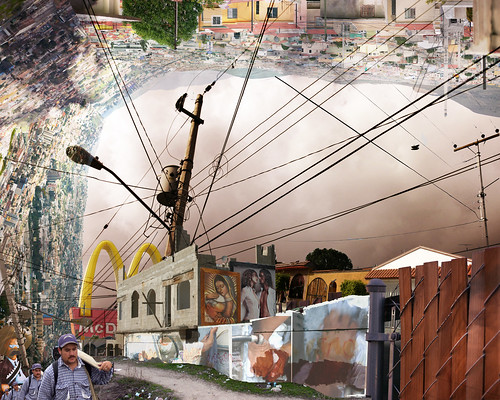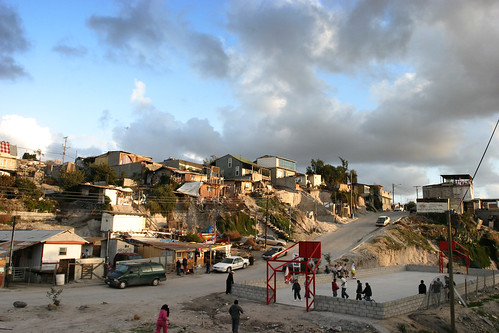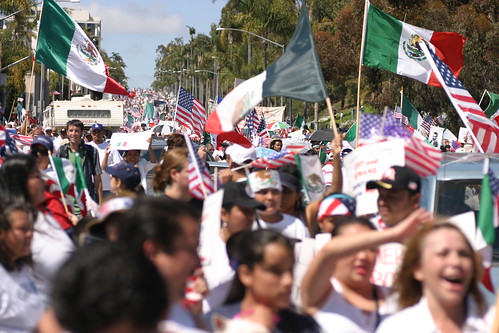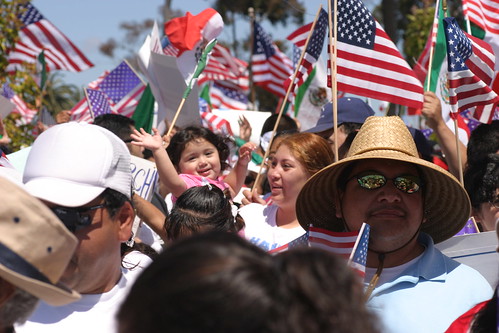This image is a collage of photographs I’ve taken in the border region of Tijuana and San Diego. I put this together as a kind of rough digital sketch of urban texture. I’m interested in visualizing the tension between U.S. and Mexican cultural landscapes, the complicated relationships between people, products, and the land.
Month: April 2006
Yesterday, I attended a lecture on architecture and urban planning in the San Diego and Tijuana region by Teddy Cruz, professor in the Visual Arts Department of UCSD. Teddy Cruz talked about a local prototype he’s planning to build in San Ysidro that addresses issue of community-based planning through local non-profits, human traffic, zoning, transformative public space, and the problems with city bureaucracy. The visual elements of the presentation illustrated his points really well. I wish I had his slides to put up here, but I did at least record it:
[display_podcast]
Cruz is a Guatemalan living in San Diego. Much of his ideas revolve around the functionality of “third world” urban planning – or lack of planning. Tijuana is an example of emergency development, the intense and immediate demand for city growth caused by massive influx of people. The people meet their own needs first, and then the bureaucracy fills in the gaps with utilities and city services. This process has led to some of the most creative urban planning around.
You can read more about his theory in this NYTimes article, Shantytowns as a New Suburban Ideal or read more about the lecture series here.
I produced a segment today for KPBS Radio’s talk show These Days. I brought on Sal Castro, a key figure who led student walkouts in the 1960s, and two UCSD professors to talk about Chicano history and identity.
Student Walkouts Hark Back to the Chicano Movement
Sal Castro, youth motivator and volunteer teacher. He mentored the students who staged walkouts in 1968. He joins us from his home in Los Angeles. Sal Castro will be at UCSD to lead a discussion following a public screening of the HBO film Walkout on Wednesday May 10 at 7 p.m. Walkout is directed by Edward James Olmos and is based on the true story of the 1968 walkouts.
Jorge Mariscal, director of the Chicano Studies Program at UC San Diego. His latest book is Brown-Eyed Children of the Sun: Lessons from the Chicano Movement.
Tomás Jiménez, Assistant Professor of Sociology at UCSD. His research focuses on immigration, race, ethnicity, inequality, assimilation, and the Mexican-origin population in the U.S.
Sunday afternoon, tens of thousands marched through downtown San Diego. The news wires report over 50,000 attended, while others estimate the count at over 80,000. I was at the march to gather sound for NPR’s Morning Edition, KQED’s California Report, and KPBS News. On site, people were saying 15,000. I have no idea how they estimate these things, and I’ve never been in a crowd that large, so I can’t really say how may people were there. Here are photos I took:
The march was completely peaceful. The organizers handed out free bottled water. The police presence was very low. Most people wore white to symbolize peace and unity. People shouted “Si se puede,” “El pueblo unido jamás será vencido,” and other chants. I spoke to a journalist who writes for the media in Mexico City, an actor from the film A Day Without A Mexican, local residents, and several undocumented immigrants. I met a husband and wife who held a sign that read, “My wife is not a criminal.” The man served in Iraq and the woman was undocumented. She was brought to the U.S. at an early age and spoke perfect, unaccented English. She said she considers herself an American.
Scenes from Tijuana
It is not my intention to perpetuate myths of a city well-known for its demons. Most people learn about Tijuana from news reports on TV about crime, violence, and corruption. No one can deny that these things exist here, just as they do every other place on earth. But life in Tijuana is much more than that. It’s an amazing place, teeming with life. It is a hybrid of dollars and pesos, English and Spanish, McDonalds and tacos.
In the past six months, I’ve been photographing pieces of this complicated cultural landscape. A work in progress, I hope the images in this series focus the viewer’s gaze on both the creativity of the city’s residents and the role of mass media culture brought to México by the U.S.



